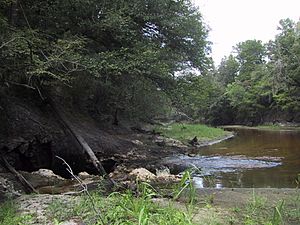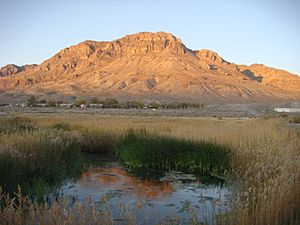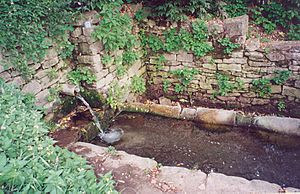Groundwater facts for kids

Groundwater is water found underground in the tiny spaces within soil and rocks. Imagine a sponge full of water – that's a bit like how water fills up the ground! When a rock layer or soil can hold a lot of water and let it flow, it's called an aquifer. The top level where the ground is completely filled with water is known as the water table.
Groundwater naturally gets refilled from rain and rivers. It also flows back to the surface in places like springs or wetlands. People often use groundwater for farming, for cities, and for factories by digging wells. Studying how groundwater moves and where it's found is called hydrogeology.
Groundwater isn't just liquid water in shallow aquifers. It can also be moisture in soil, frozen water in permafrost, or even deep water mixed with oil. Scientists think groundwater might even help faults (cracks in the Earth's crust) move. Water might exist deep inside Earth and even on other planets like Mars or Jupiter's moon Europa!
Contents
What are Aquifers?
An aquifer is like an underground storage tank made of rock or soil that holds and moves groundwater. If water can easily flow from the surface down into an aquifer, it's called an unconfined aquifer. The deeper parts of these aquifers usually have more water because gravity pulls it downwards.
The very top of this water-filled layer in an unconfined aquifer is the water table. Below the water table, all the tiny spaces in the ground are full of water.
Some ground layers don't let much water through. A layer that lets only a little water pass is an aquitard. A layer that hardly lets any water through at all is an aquiclude.
A confined aquifer is an aquifer that has a layer of rock or soil, like an aquiclude, on top of it. This top layer acts like a lid. If a confined aquifer slopes downhill from where it gets refilled, the water inside can become pressurized. This pressure can create artesian wells, where water flows out freely without needing a pump!
Aquifers are different depending on the types of rocks and land around them. The best aquifers for getting water are often found in layers of sedimentary rock. Water in the ground stays at a pretty steady temperature because of the soil and rock around it. This steady temperature can be used to help heat or cool buildings using heat pumps.
The Water Cycle and Groundwater

Groundwater makes up about 20% of the world's fresh water. That's a huge amount! It's about 0.61% of all the water on Earth, including oceans and ice.
Groundwater is naturally refilled by rain, streams, and rivers. This refilling happens when surface water soaks into the ground and reaches the water table. In fact, groundwater holds 30.1% of all freshwater on Earth. Only icecaps and glaciers hold more, at 68.7%.
Groundwater can stay underground for a very long time – from days to thousands of years! This makes it a long-term storage place in the natural water cycle. Water in the atmosphere or on the surface (like in rivers) usually stays there for much shorter times.
The Great Artesian Basin in Australia is one of the biggest confined aquifer systems in the world. It covers almost 2 million square kilometers! Scientists have studied the water from deep underground there. They found that some of this water can be more than 1 million years old!
By comparing the age of groundwater in different parts of the Great Artesian Basin, scientists learned that the water gets older as it flows westward. This means that to travel almost 1,000 kilometers from where it started, the groundwater moves at about 1 meter (about 3 feet) per year. That's super slow!
Drinking Groundwater
People drink groundwater by using water wells. They drill these wells deep into the ground until they reach an aquifer. Then, pumps are used to bring the stored groundwater up to the surface so people can use it for drinking and other needs.
Images for kids
-
An illustration showing groundwater in aquifers (in blue) (1, 5 and 6) below the water table (4), and three different wells (7, 8 and 9) dug to reach it.
-
Groundwater may be extracted through a water well
-
Iron (III) oxide staining (after water capillary rise in a wall) caused by oxidation of dissolved iron (II) and its subsequent precipitation, from an unconfined aquifer in karst topography. Perth, Western Australia.
See also
 In Spanish: Agua subterránea para niños
In Spanish: Agua subterránea para niños





